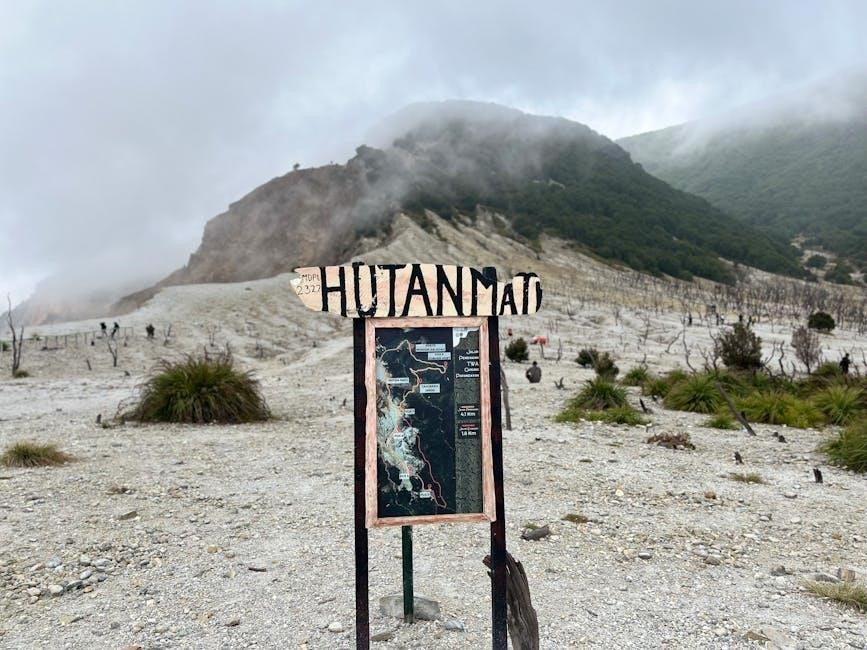superior hiking trail map pdf

The Superior Hiking Trail Map PDF guides hikers along the 310-mile path from Duluth to the Canadian border, offering detailed topography, campsites, trailheads, and landmarks for navigation and planning.
1.1 Overview of the Superior Hiking Trail
The Superior Hiking Trail spans 310 miles along Minnesota’s North Shore of Lake Superior, from Duluth to the Canadian border. Known for its rugged terrain and scenic beauty, the trail features 53 trailheads, 93 backcountry campsites, and diverse landscapes, including forests, cliffs, and rivers. Elevated at 1,750 feet, it offers stunning vistas of Lake Superior. Ideal for both day hikes and thru-hikes, the trail caters to all skill levels, providing an unforgettable outdoor experience for hikers.
1.2 Importance of the Trail Map for Hikers
The Superior Hiking Trail Map PDF is crucial for hikers, providing detailed navigation aids, campsites, trailheads, and landmarks. It ensures hikers stay on track, especially in remote areas with limited signage. The map highlights distances between campsites and trailheads, aiding in itinerary planning and resource management. It also identifies challenging sections and potential hazards, enhancing safety. Carrying this map is essential for responsible hiking, making it a must-have resource for exploring the trail confidently and safely.
Geography and Layout of the Superior Hiking Trail
The Superior Hiking Trail spans from Duluth to Grand Portage, covering diverse landscapes like forests, cliffs, and rivers, with key sections like Temperance River to Pincushion Mountain and beyond.
2.1 Total Length and Key Sections of the Trail
The Superior Hiking Trail spans 310 miles, from Duluth to the Canadian border. Key sections include the Temperance River to Pincushion Mountain (53.2 miles) and Pincushion Mountain to Northern Terminus (54.2 miles), offering diverse terrain and scenic views. These sections cross Cook County, connecting to the Border Route Trail at the northern end, and provide access to stunning overlooks and remote wilderness areas for hikers to explore.
2.2 Trailheads and Access Points
The Superior Hiking Trail features 53 trailheads, providing easy access to the 310-mile route. Many trailheads include parking lots, making it convenient for day hikes or thru-hikes. Key access points are located in Duluth and Cook County, with additional entries along Lake Superior’s North Shore. These trailheads connect hikers to diverse sections of the trail, offering opportunities to explore forests, cliffs, and scenic overlooks while ensuring a well-distributed network for adventure planning.
2.3 Connecting Trails and Nearby Routes
The Superior Hiking Trail connects to the Border Route Trail at its northern terminus, offering extended exploration opportunities. Spur trails lead to scenic overlooks, waterfalls, and Lake Superior shores. Nearby routes include loops in Gooseberry Falls, Split Rock, and Tettegouche State Parks, enhancing the trail network. These connections provide hikers with diverse options to explore Minnesota’s North Shore, combining the SHT with other regional trails for a richer outdoor experience.

Features of the Superior Hiking Trail Map PDF
The Superior Hiking Trail Map PDF includes detailed topography, campsites, trailheads, summits, and landmarks. It highlights mile markers, challenging sections, and potential hazards, aiding navigation and planning for hikers.
3.1 Detailed Topographic Markings

The Superior Hiking Trail Map PDF features detailed topographic markings, including contour lines, elevations, and terrain variations. These markings help hikers navigate challenging sections, plan routes, and identify scenic overlooks. The map highlights river crossings, steep inclines, and unique geological formations, ensuring hikers are well-prepared for the trail’s diverse landscape. This level of detail is essential for safe navigation, especially in remote areas with limited signage, making it a vital tool for both day hikes and multi-day adventures.
3.2 Identification of Campsites and Trailheads
The Superior Hiking Trail Map PDF clearly marks 93 backcountry campsites, each equipped with tent pads, and 53 trailheads, many with parking areas. These markers help hikers identify convenient stopping points and access areas, simplifying itinerary planning. The map also notes distances between campsites and trailheads, aiding in supply management and route organization. This feature is particularly useful for backpackers and long-distance hikers needing to plan logistics effectively.
3.3 Marking of Summits and Landmarks
The Superior Hiking Trail Map PDF highlights key summits like Oberg Mountain and Carlton Peak, offering breathtaking views. It also marks landmarks such as waterfalls, river crossings, and unique geological formations. Elevations are noted, with the trail reaching up to 1,750 feet, providing panoramic vistas of Lake Superior. These markers serve as navigational aids and iconic destinations, showcasing the trail’s natural beauty and helping hikers explore its diverse terrain and scenic wonders effectively.
How to Use the Superior Hiking Trail Map
The Superior Hiking Trail Map PDF aids in navigation, understanding symbols, and planning hikes. It ensures hikers stay on track and prepared for their adventure effectively.
4.1 Navigating with the Map
The Superior Hiking Trail Map PDF provides clear trail routes, mile markers, and symbols to help hikers stay oriented. It highlights campsites, trailheads, and landmarks, ensuring easy navigation. The detailed topography aids in identifying terrain challenges, while the legend explains symbols for quick reference. Hikers can plan their itinerary by tracking distances between campsites and trailheads, making it essential for both short and long hikes. Understanding the map’s scale and markings is key to staying on course and enjoying the trail confidently.
4.2 Understanding Map Symbols and Legends
The Superior Hiking Trail Map PDF uses specific symbols and a detailed legend to represent key features like campsites, trailheads, and summits. These symbols help hikers quickly identify important locations and trail markers. The legend explains the meaning of each symbol, ensuring users can interpret the map accurately. Understanding these elements is crucial for effective navigation and planning, allowing hikers to make informed decisions about their route and resources along the trail.
4.3 Planning Your Hike with the Map
The Superior Hiking Trail Map PDF is essential for planning your adventure, offering detailed mile markers, campsites, and trailheads. Use it to create itineraries, manage food and water supplies, and prepare for challenging sections. The map helps hikers assess trail difficulty, identify scenic stops, and plan rest days. Whether for a day hike or a thru-hike, the map ensures a well-organized and enjoyable journey along Lake Superior’s stunning trails.
Digital Tools and Resources
Custom Google Maps, GPS apps, and interactive tools enhance navigation and planning for hikers, complementing the Superior Hiking Trail Map PDF with dynamic route and landmark details.
5.1 Custom Google Maps for the Trail
Custom Google Maps for the Superior Hiking Trail provide an interactive way to explore the 310-mile route. These maps feature campsites, trailheads, and shuttle pickup locations, aiding in route planning and navigation. They offer a visual overview, allowing users to zoom in for detailed sections or out for a broader perspective. While they don’t replace the detailed guidebook, they complement the traditional PDF maps with a dynamic, user-friendly experience for digital-savvy hikers.
5.2 GPS and App Integration
GPS and app integration enhance navigation on the Superior Hiking Trail. Apps like Locus Maps allow hikers to import GPX files of the trail and campsites, providing real-time navigation. This feature is especially useful in remote areas with limited signage. By syncing the trail map with GPS data, hikers can track their progress and locate key points like campsites and trailheads. This technology ensures accurate navigation, even in areas with poor internet connectivity, making it an essential tool for both section and thru-hikers.
5.3 Interactive Tools for Hikers
Interactive tools like custom Google Maps and GPX files enhance the hiking experience on the Superior Hiking Trail. These tools allow hikers to explore the trail digitally, marking campsites, trailheads, and shuttle pickup locations. Interactive maps provide a visual overview of the trail’s layout, enabling hikers to plan routes and navigate efficiently. They complement the PDF map by offering a dynamic, user-friendly experience, making it easier to plan and execute hikes along the 310-mile trail.

Guidebooks and Databooks

The Superior Hiking Trail Guidebook and Databook offer detailed trail descriptions, maps, and practical tips, while supporting trail maintenance through their purchase. Both are available in print and digital formats.
6.1 Comprehensive Guidebook Details
The Superior Hiking Trail Guidebook provides in-depth descriptions of the 310-mile trail, including detailed maps, historical insights, and tips for navigating diverse terrain. It covers the trail’s geology, wildlife, and scenic highlights, making it an invaluable resource for both day hikes and thru-hikes. The guidebook also offers practical advice on planning, safety, and preparation, ensuring hikers are well-equipped for their adventure. It is available in print and digital formats, catering to all preferences and needs.
6.2 Databook for On-the-Go Reference
The Databook serves as a compact, portable reference for hikers, detailing mileages, campsites, and trailheads along the Superior Hiking Trail. It provides essential information for backpackers to track distances and manage supplies. Designed for on-the-go use, the Databook complements the guidebook by offering quick access to critical data. Its concise format makes it ideal for navigating the trail without carrying bulky materials. Purchasing the Databook supports trail maintenance and conservation efforts, ensuring the trail remains accessible for future hikers.
6.3 Additional Resources for Hikers
Beyond the guidebook and databook, hikers can access custom Google Maps for visual route planning and GPS-integrated apps like Locus Maps for real-time navigation. These tools enhance the hiking experience by providing interactive features and shuttle pickup locations. Additionally, the Superior Hiking Trail Association offers online resources, including trail updates and community forums, to help hikers prepare and connect. These resources ensure a well-rounded and supported adventure along the Superior Hiking Trail.

Safety and Preparedness
Carry a physical map, as GPS signals can be unreliable. Plan your route, inform someone of your itinerary, and pack essentials like water, a first-aid kit, and extra clothing.
7.1 Essential Safety Tips for Hikers
Always carry a physical map and inform someone of your itinerary. Pack essentials like water, a first-aid kit, and extra clothing. Check weather forecasts and trail conditions before heading out. Use trail markers to stay on course and respect wildlife by maintaining a safe distance. Stay hydrated and manage food supplies, especially on longer sections. Be prepared for emergencies with a plan and reliable shelter. Familiarize yourself with the map’s scale and symbols for better navigation.
7.2 Managing Weather Conditions
The Superior Hiking Trail experiences unpredictable weather, with sudden rain and temperature drops. Always check forecasts before hiking and carry layers, waterproof gear, and a map. Use the map to locate shelters or lower elevations if storms arise. Stay informed about trail conditions, especially in winter, when snow and ice require specialized gear. Be prepared for varying conditions to ensure a safe and enjoyable hiking experience along Lake Superior’s rugged terrain.
7.3 Emergency Preparedness
Always carry a physical map and inform someone of your itinerary. Pack essentials like a first-aid kit, headlamp, and emergency shelter. Be prepared for sudden weather changes and know how to use your map to locate trailheads or ranger stations if help is needed. Stay vigilant and carry a means of communication, as GPS signals can be unreliable in remote areas. Proper preparation ensures safety and quick response in case of emergencies.
Best Time to Hike the Superior Hiking Trail
The best time to hike is late spring to early fall, with summer offering warm weather and long days. Early fall provides stunning foliage, while winter requires special preparation.

8.1 Seasonal Considerations
The Superior Hiking Trail is best hiked from late spring to early fall, with summer offering warm weather and long days. Early fall provides stunning foliage, making September and October ideal for scenic views. Winter hiking is possible but requires special preparation due to cold temperatures and deep snow. Spring can be muddy, while summer brings black flies and mosquitoes. Always check weather forecasts and trail conditions before planning your hike along Lake Superior.
8.2 Weather and Trail Conditions
The Superior Hiking Trail experiences variable weather, with rain, fog, and rapid temperature changes common. Trail conditions vary by season: muddy in spring, dry in summer, and snowy in winter. Summer offers warm weather but brings black flies and mosquitoes. Early fall provides ideal hiking conditions with cooler temperatures and vibrant foliage. Always check weather forecasts and trail condition reports before heading out. Use the Superior Hiking Trail Map PDF to plan according to the season and terrain.
8.3 Avoiding Hazardous Seasons
The Superior Hiking Trail can be hazardous during extreme weather seasons. Winter brings heavy snow and subzero temperatures, making trails impassable without proper gear. The Superior Hiking Trail Map PDF helps identify sections prone to deep snow and icy conditions. Avoid hiking during early spring thaw when trails are muddy and unstable. Check trail condition reports and weather forecasts to plan your hike safely, ensuring you avoid risky periods and prepare accordingly for the season.

Availability and Purchase Options

The Superior Hiking Trail Map PDF is available in digital and print formats, purchasable online or at select retail locations along Lake Superior’s North Shore, supporting trail maintenance.
9.1 Where to Buy the Map
The Superior Hiking Trail Map PDF is available for purchase through the Superior Hiking Trail Association website or at select retail locations along Lake Superior’s North Shore. Online purchases offer convenience, while local retailers provide easy access for those already in the region. The map is sold in both digital and print formats, catering to different preferences. Proceeds from sales support trail maintenance and conservation efforts, making it a worthwhile investment for hikers and trail enthusiasts alike.
9.2 Digital vs. Print Formats
The Superior Hiking Trail Map PDF is available in both digital and print formats, catering to different preferences. The digital version offers convenience, easy updates, and portability for use on smartphones or tablets. The print version provides a tactile experience, ideal for pre-trip planning or as a backup in areas with limited internet access. Both formats ensure hikers have reliable navigation tools, with proceeds supporting trail maintenance and conservation efforts.
9.3 Supporting Trail Maintenance
Purchasing the Superior Hiking Trail Map PDF directly supports trail maintenance and conservation efforts. Proceeds from sales fund essential work, such as trail rerouting, sign installation, and habitat preservation. By buying official resources, hikers contribute to the trail’s sustainability, ensuring it remains accessible and pristine for future adventurers. This investment not only enhances the hiking experience but also protects the natural beauty of Lake Superior’s North Shore for generations to come.

Conclusion
The Superior Hiking Trail Map PDF is an indispensable resource for hikers, offering detailed navigation and planning tools while supporting trail maintenance and conservation efforts, ensuring a safe and enjoyable experience for all hikers.
10.1 Final Thoughts on the Superior Hiking Trail Map PDF
The Superior Hiking Trail Map PDF is an indispensable tool for hikers, providing detailed insights and navigation aids for a safe and enjoyable journey. Its comprehensive markings of campsites, trailheads, and landmarks ensure hikers stay prepared and informed. By supporting trail maintenance through purchases, hikers contribute to preserving this natural gem. Whether for a day hike or a thru-hike, the map is a vital resource, offering unparalleled guidance for exploring the trail’s stunning landscapes and scenic beauty.
10.2 Encouragement to Explore the Trail
Embark on an unforgettable journey along the Superior Hiking Trail, where breathtaking views of Lake Superior, rugged terrain, and scenic overlooks await. With its well-marked paths and diverse landscapes, the trail offers an adventure for every skill level. Whether you’re seeking solitude, challenging hikes, or stunning vistas, the SHT promises an enriching experience. Grab your map, lace up your boots, and immerse yourself in the natural beauty of Minnesota’s North Shore—your next adventure is just a step away!